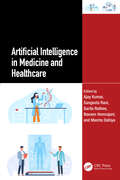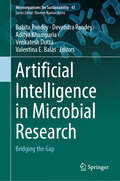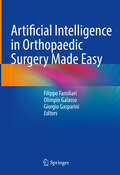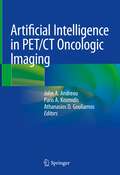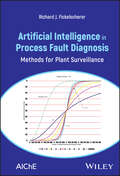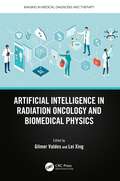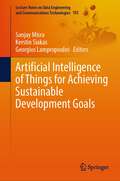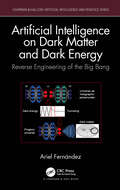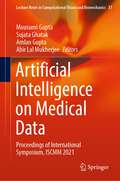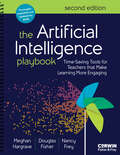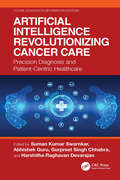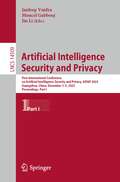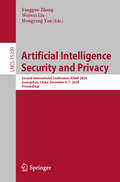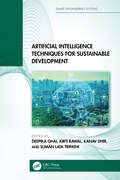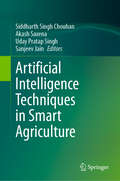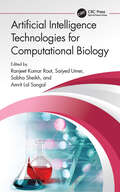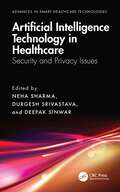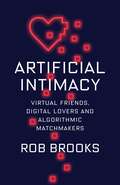- Table View
- List View
Artificial Intelligence in Medicine and Healthcare
by Ajay Kumar Sangeeta Rani Sarita Rathee Naveen Hemrajani Mamta DahiyaThis book is discussing artificial intelligence-based smart systems for diagnosis and prediction of diseases, artificial intelligence in clinical decision-making, and artificial intelligence tools for clinical and healthcare data. It further highlights the importance of 5G and 6G communication for telemedicine applications and applications of machine learning and deep learning in pandemic epidemiology.This book: Discusses artificial intelligence-inspired Internet of Things-based solutions, and machine learning modeling for smart healthcare Explains the use of computer vision, natural language processing in healthcare, and artificial intelligence in clinical decision-making Illustrates the role of artificial intelligence in telemedicine applications Examines medical image analysis using machine learning, and deep learning techniques It is primarily written for senior undergraduates, graduate students, and academic researchers in the fields including computer science and engineering, electronics and communications engineering, and biomedical engineering.
Artificial Intelligence in Microbial Research: Bridging the Gap (Microorganisms for Sustainability #45)
by Valentina E. Balas Aditya Khamparia Venkatesh Dutta Devendra Pandey Babita PandeyThis book explores the convergence of microbiology and artificial intelligence (AI) and delves into the intricate world of microbial systems enhanced by cutting-edge AI technologies. The book begins by establishing a foundation in the fundamentals of microbial ecosystems and AI principles. It elucidates the integration of AI in microbial genomics, demonstrating how advanced algorithms analyze genomic data and contribute to genetic engineering. Bioinformatics and computational microbiology are explored, showcasing AI's role in predictive modeling and computational tools. The intersection of AI and microbial applications extends to drug discovery, precision agriculture, and pathogen detection. Readers gain insights into AI-driven drug development, the optimization of agricultural practices using microbial biostimulants, and early warning systems for crop diseases. The book highlights AI's role in microbial biotechnology, elucidating its impact on bioprocessing, fermentation, and other biotechnological applications. Climate-smart agriculture and microbial adaptations to environmental challenges are discussed, emphasizing sustainable practices. This book caters to a diverse audience including teachers, researchers, microbiologist, computer bioinformaticians, plant and environmental scientists. The book serves as additional reading material for undergraduate and graduate students of computer science, biomedical, agriculture, human science, forestry, ecology, soil science, and environmental sciences and policy makers to be a useful to read.
Artificial Intelligence in Orthopaedic Surgery Made Easy
by Filippo Familiari Olimpio Galasso Giorgio GaspariniThis book is an essential reference guide for the use of artificial intelligence in orthopaedic surgery. It covers all related topics, from machine and deep learning, through practical applications in all orthopaedic sub-disciplines, to ethical issues and potential risks. International renowned experts equip the reader with solid scientific foundations and practical tips combining accurate literature reviews with high-quality original images. Addressing a hot topic for the present and next generation of medical specialists, this book is a must read for orthopaedic surgeons, radiologists and health informatic specialists alike.
Artificial Intelligence in PET/CT Oncologic Imaging
by John A. Andreou Paris A. Kosmidis Athanasios D. GouliamosThis book presents artificial intelligence applications that may help in detecting disease, defining tissue characterization (benign vs malignant), staging and correlation with molecular biomarkers. Originally positioned as a means for noninvasive molecular phenotyping and quantification in the 1970s, PET's technological improvements in the 2000s generated renewed interest in quantification, which has grown over the last five years. This progress is parallel with the development of Artificial intelligence (AI) systems for Oncology which aim at providing the best possible treatment to patients suffering from lung, breast, brain, prostate, liver and other types of cancer. The chapters provide an overview of the use of AI in PET/CT imaging for various types of cancer, and it will be an invaluable tool especially for nuclear medicine physicians and oncologists.
Artificial Intelligence in Process Fault Diagnosis: Methods for Plant Surveillance
by Richard J. FickelschererArtificial Intelligence in Process Fault Diagnosis A comprehensive guide to the future of process fault diagnosis Automation has revolutionized every aspect of industrial production, from the accumulation of raw materials to quality control inspections. Even process analysis itself has become subject to automated efficiencies, in the form of process fault analyzers, i.e., computer programs capable of analyzing process plant operations to identify faults, improve safety, and enhance productivity. Prohibitive cost and challenges of application have prevented widespread industry adoption of this technology, but recent advances in artificial intelligence promise to place these programs at the center of manufacturing process analysis. Artificial Intelligence in Process Fault Diagnosis brings together insights from data science and machine learning to deliver an effective introduction to these advances and their potential applications. Balancing theory and practice, it walks readers through the process of choosing an ideal diagnostic methodology and the creation of intelligent computer programs. The result promises to place readers at the forefront of this revolution in manufacturing. Artificial Intelligence in Process Fault Diagnosis readers will also find: Coverage of various AI-based diagnostic methodologies elaborated by leading expertsGuidance for creating programs that can prevent catastrophic operating disasters, reduce downtime after emergency process shutdowns, and moreComprehensive overview of optimized best practices Artificial Intelligence in Process Fault Diagnosis is ideal for process control engineers, operating engineers working with processing industrial plants, and plant managers and operators throughout the various process industries.
Artificial Intelligence in Radiation Oncology and Biomedical Physics (Imaging in Medical Diagnosis and Therapy)
by Gilmer Valdes Lei XingThis pioneering book explores how machine learning and other AI techniques impact millions of cancer patients who benefit from ionizing radiation. It features contributions from global researchers and clinicians, focusing on the clinical applications of machine learning for medical physics. AI and machine learning have attracted much recent attention and are being increasingly adopted in medicine, with many clinical components and commercial software including aspects of machine learning integration. General principles and important techniques in machine learning are introduced, followed by discussion of clinical applications, particularly in radiomics, outcome prediction, registration and segmentation, treatment planning, quality assurance, image processing, and clinical decision-making. Finally, a futuristic look at the role of AI in radiation oncology is provided. This book brings medical physicists and radiation oncologists up to date with the most novel applications of machine learning to medical physics. Practitioners will appreciate the insightful discussions and detailed descriptions in each chapter. Its emphasis on clinical applications reaches a wide audience within the medical physics profession.
Artificial Intelligence, Learning and Computation in Economics and Finance (Understanding Complex Systems)
by Ragupathy VenkatachalamThis book presents frontier research on the use of computational methods to model complex interactions in economics and finance. Artificial Intelligence, Machine Learning and simulations offer effective means of analyzing and learning from large as well as new types of data. These computational tools have permeated various subfields of economics, finance, and also across different schools of economic thought. Through 16 chapters written by pioneers in economics, finance, computer science, psychology, complexity and statistics/econometrics, the book introduces their original research and presents the findings they have yielded.Theoretical and empirical studies featured in this book draw on a variety of approaches such as agent-based modeling, numerical simulations, computable economics, as well as employing tools from artificial intelligence and machine learning algorithms. The use of computational approaches to perform counterfactual thought experiments are also introduced, which help transcend the limits posed by traditional mathematical and statistical tools.The book also includes discussions on methodology, epistemology, history and issues concerning prediction, validation, and inference, all of which have become pertinent with the increasing use of computational approaches in economic analysis.
Artificial Intelligence Models for the Dark Universe: Forays in Mathematical Cosmology
by Ariel FernándezThe dark universe contains matter and energy unidentifiable with current physical models, accounting for 95% of all the matter and energetic equivalent in the universe. The enormous surplus brings up daunting enigmas, such as the cosmological constant problem and the apparent distortions in the dynamics of deep space, and so coming to grips with the invisible universe has become a scientific imperative.This book addresses this need, reckoning that no cogent physical model of the dark universe can be implemented without first addressing the metaphysical hurdles along the way. The foremost problem is identifying the topology of the universe which, as argued in the book, is highly relevant to unveil the secrets of the dark universe.Artificial Intelligence (AI) is a valuable tool in this effort since it can reconcile conflicting data from deep space with the extant laws of physics by building models to decipher the dark universe. This book explores the applications of AI and how it can be used to embark on a metaphysical quest to identify the topology of the universe as a prerequisite to implement a physical model of the dark sector that enables a meaningful extrapolation into the visibile sector.The book is intended for a broad readership, but a background in college-level physics and computer science is essential. The book will be a valuable guide for graduate students as well as researchers in physics, astrophysics, and computer science focusing on AI applications to elucidate the nature of the dark universe.Key Features:· Provides readers with an intellectual toolbox to understand physical arguments on dark matter and energy.· Up to date with the latest cutting-edge research.· Authored by an expert on artificial intelligence and mathematical physics.
Artificial Intelligence of Things for Achieving Sustainable Development Goals (Lecture Notes on Data Engineering and Communications Technologies #192)
by Sanjay Misra Kerstin Siakas Georgios LampropoulosThis book covers various topics and trends regarding Artificial Intelligence (AI), Internet of Things (IoT), and their applications in society, industry, and environment for achieving Sustainable Development Goals (SDGs) suggested by the United Nations. Additionally, it discusses their advancements and fusion as well as the realization of Artificial Intelligence of Things (AIoT). The book aims to provide an overview and recent research into the fusion, integration, advancements, and impact of these technologies in the context of SDGs achievement. The topics include the applications of AI, IoT, big data, AI-based and IoT-based cloud computing, machine learning and deep learning techniques, and blockchain among others for achieving SDGs. It also presents findings and discussions on potential application domains, addresses open issues and challenges, offers solutions, and provides suggestions for future research for achieving SDGs. The chapters are clustered, according to particular SDGsor areas of focus, into: i) the realization of AIoT for SDGs, ii) the role of AIoT in achieving society and wellbeing-related SDGs, iii) the fulfillment of industrial sectors, infrastructure, and economy-related SDGs through AIoT, and iv) the use of AIoT to aid natural resources and environment-related SDGs. The book assists researchers, practitioners, professionals, and academicians of various scientific fields in exploring and better understanding these state-of-the-art technologies, their advancements, impact, future potentials and benefits, and their role in successfully achieving SDGs.The book:· Offers an in-depth overview of AIoT for achieving SDGs.· Presents the fusion of AI and IoT for bringing a significant change in everyday life and fulfilling SDGs.· Highlights innovative solutions and results of AIoT integration in several domains for achieving SDGs.· Showcases the influence of AIoT on promoting and improving sustainability in the context of SDGs.· Discusses the issues, benefits, solutions, and impact of AIoT in society, industry, and environment for achieving SDGs.
Artificial Intelligence on Dark Matter and Dark Energy: Reverse Engineering of the Big Bang (Chapman & Hall/CRC Artificial Intelligence and Robotics Series)
by Ariel FernándezAs we prod the cosmos at very large scales, basic tenets of physics seem to crumble under the weight of contradicting evidence. This book helps mitigate the crisis. It resorts to artificial intelligence (AI) for answers and describes the outcome of this quest in terms of an ur-universe, a quintessential compact multiply connected space that incorporates a fifth dimension to encode space-time as a latent manifold. In some ways, AI is bolder than humans because the huge corpus of knowledge, starting with the prodigious Standard Model (SM) of particle physics, poses almost no burden to its conjecture-framing processes. Why not feed AI with the SM enriched by the troubling cosmological phenomenology on dark matter and dark energy and see where AI takes us vis-à-vis reconciling the conflicting data with the laws of physics? This is precisely the intellectual adventure described in this book and – to the best of our knowledge – in no other book on the shelf. As the reader will discover, many AI conjectures and validations ultimately make a lot of sense, even if their boldness does not feel altogether "human" yet. This book is written for a broad readership. Prerequisites are minimal, but a background in college math/physics/computer science is desirable. This book does not merely describe what is known about dark matter and dark energy but also provides readers with intellectual tools to engage in a quest for the deepest cosmological mystery.
Artificial Intelligence on Medical Data: Proceedings of International Symposium, ISCMM 2021 (Lecture Notes in Computational Vision and Biomechanics #37)
by Mousumi Gupta Sujata Ghatak Amlan Gupta Abir Lal MukherjeeThis book includes high-quality papers presented at the Second International Symposium on Computer Vision and Machine Intelligence in Medical Image Analysis (ISCMM 2021), organized by Computer Applications Department, SMIT in collaboration with Department of Pathology, SMIMS, Sikkim, India, and funded by Indian Council of Medical Research, during 11 – 12 November 2021. It discusses common research problems and challenges in medical image analysis, such as deep learning methods. It also discusses how these theories can be applied to a broad range of application areas, including lung and chest x-ray, breast CAD, microscopy and pathology. The studies included mainly focus on the detection of events from biomedical signals.
The Artificial Intelligence Playbook: Time-Saving Tools for Teachers that Make Learning More Engaging
by Douglas Fisher Nancy Frey Meghan HargraveTime Saving AI Tools that Make Learning More Engaging Busy educators need tools that support their planning and provide them with more time with students. While Artificial Intelligence (AI) has emerged as a promising solution, it can only help if we’re willing to learn how to use it in ways that improve upon what we already do well. The Artificial Intelligence Playbook: Time Saving Tools that Make Learning More Engaging is here to empower teachers to explore AI’s potential and discover practical ways to implement it to enhance their planning and instruction. Two chapters and 6 "Educator Functions" guide teachers step-by-step through how to purposely use AI to: Compose Writing Prompts and Avoid Plagiarism Manage Content Foster Student Engagement Meet Students’ Instructional Needs Assess Student Learning Continue Lifelong Learning Though AI has the potential to reduce workload for educators, it will never replace teachers. Your connection with students is irreplaceable—and greatly impacts their learning. Consider AI a valuable tool that provides you with more time to build and sustain those vital relationships with students and that can assist them in learning at the very same time.
The Artificial Intelligence Playbook: Time-Saving Tools for Teachers that Make Learning More Engaging
by Douglas Fisher Nancy Frey Meghan HargraveTime Saving AI Tools that Make Learning More Engaging Busy educators need tools that support their planning and provide them with more time with students. While Artificial Intelligence (AI) has emerged as a promising solution, it can only help if we’re willing to learn how to use it in ways that improve upon what we already do well. The Artificial Intelligence Playbook: Time Saving Tools that Make Learning More Engaging is here to empower teachers to explore AI’s potential and discover practical ways to implement it to enhance their planning and instruction. Two chapters and 6 "Educator Functions" guide teachers step-by-step through how to purposely use AI to: Compose Writing Prompts and Avoid Plagiarism Manage Content Foster Student Engagement Meet Students’ Instructional Needs Assess Student Learning Continue Lifelong Learning Though AI has the potential to reduce workload for educators, it will never replace teachers. Your connection with students is irreplaceable—and greatly impacts their learning. Consider AI a valuable tool that provides you with more time to build and sustain those vital relationships with students and that can assist them in learning at the very same time.
The Artificial Intelligence Playbook: Time-Saving Tools for Teachers that Make Learning More Engaging
by Douglas Fisher Nancy Frey Meghan HargraveThe Latest Time Saving AI Tools that Make Learning More Engaging Busy educators need tools that support their planning and provide them with more time with students. While artificial intelligence (AI) has emerged as a promising solution, it can only help if we’re willing to continuously learn how to use it in ways that improve upon what we already do well. The Artificial Intelligence Playbook: Time-Saving Tools for Teachers that Make Learning More Engaging, Second Edition, is a thoroughly updated, expanded new edition that reflects the transformative changes that have emerged since the first publication, offering updated strategies, insights, research, and examples that address the latest developments in AI technology. Learn how to purposefully use AI with: Best practices for composing effective prompts for optimal output and incorporating images, PDFs, or other documents with those prompts An expanded look at the responsible use of generative AI, addressing plagiarism, citations, and other common concerns New strategies and research supporting AI literacy instruction to prepare students for an AI-powered future More classroom examples demonstrating AI use cases for instructional best practices across various grade levels Practical ways to implement AI to enhance teaching functions from planning, instruction, assessment, student engagement, and more. Though AI has the potential to reduce workload for educators, it will never replace teachers. Your connection with students is irreplaceable—and greatly impacts their learning. With The Artificial Intelligence Playbook, Second Edition, in hand, educators will find even more time-saving tools to help build and sustain those vital relationships with students all while enhancing learning and engagement in the classroom.
The Artificial Intelligence Playbook: Time-Saving Tools for Teachers that Make Learning More Engaging
by Douglas Fisher Nancy Frey Meghan HargraveThe Latest Time Saving AI Tools that Make Learning More Engaging Busy educators need tools that support their planning and provide them with more time with students. While artificial intelligence (AI) has emerged as a promising solution, it can only help if we’re willing to continuously learn how to use it in ways that improve upon what we already do well. The Artificial Intelligence Playbook: Time-Saving Tools for Teachers that Make Learning More Engaging, Second Edition, is a thoroughly updated, expanded new edition that reflects the transformative changes that have emerged since the first publication, offering updated strategies, insights, research, and examples that address the latest developments in AI technology. Learn how to purposefully use AI with: Best practices for composing effective prompts for optimal output and incorporating images, PDFs, or other documents with those prompts An expanded look at the responsible use of generative AI, addressing plagiarism, citations, and other common concerns New strategies and research supporting AI literacy instruction to prepare students for an AI-powered future More classroom examples demonstrating AI use cases for instructional best practices across various grade levels Practical ways to implement AI to enhance teaching functions from planning, instruction, assessment, student engagement, and more. Though AI has the potential to reduce workload for educators, it will never replace teachers. Your connection with students is irreplaceable—and greatly impacts their learning. With The Artificial Intelligence Playbook, Second Edition, in hand, educators will find even more time-saving tools to help build and sustain those vital relationships with students all while enhancing learning and engagement in the classroom.
Artificial Intelligence Revolution: How AI Will Change our Society, Economy, and Culture
by Robin LiThe co-founder of Baidu explains how AI will transform human livelihood, from our economy and financial systems down to our daily lives. Written by Baidu cofounder Robin Li and prefaced by award-winning sci-fi writer Cixin Liu (author of The Three-Body Problem), Artificial Intelligence Revolution introduces Baidu&’s teams of top scientists and management as pioneers of movement toward AI. The book covers many of the latest AI-related ideas and technological developments, such as: Computational abilityBig data resourcesSetting the basic standards of AI in research and developmentAn introduction to the &“super brain&”Intelligent manufacturingDeep learningL4 automated vehiclesSmart finance The book describes the emergence of a &“smart&” society powered by technology and reflects on the challenges humanity is about to face. Li covers the most pressing AI-related ideas and technological developments, including: Will artificial intelligence replace human workers, and in what sectors of the economy? How will it affect healthcare and finance? How will daily human life change? Robin Li&’s Artificial Intelligence Revolution addresses these questions and more from the perspective of a pioneer of AI development. It's a must-read for anyone concerned about the emergence of a &“smart&” society powered by technology and the challenges humanity is about to face.
Artificial Intelligence Revolutionizing Cancer Care: Precision Diagnosis and Patient-Centric Healthcare (Future Generation Information Systems)
by Suman Kumar Swarnkar Abhishek Guru Gurpreet Singh Chhabra Harshitha Raghavan DevarajanIn the ever-evolving landscape of cancer treatment, the fusion of artificial intelligence (AI) with medical science marks a groundbreaking shift toward more precise, efficient, and personalized healthcare. Artificial Intelligence Revolutionizing Cancer Care: Precision Diagnosis and Patient-Centric Healthcare delves into the transformative power of AI, offering a comprehensive exploration of its role in enhancing cancer diagnosis, treatment, and patient management. This edited volume brings together leading experts and researchers who illuminate the latest advancements in AI technologies applied to oncology. From machine learning algorithms that predict cancer progression to sophisticated imaging techniques that improve diagnostic accuracy, this book covers a spectrum of innovations reshaping cancer care. Key highlights include precision diagnosis, uncovering how AI-driven tools are revolutionizing the early detection and accurate classification of various cancer types, leading to better patient outcomes; patient-centric approaches, exploring the shift toward personalized medicine, where AI tailors treatment protocols to individual patient profiles, ensuring more effective and targeted therapies; and ethical and practical considerations, gaining insights into the ethical, practical, and regulatory challenges of integrating AI in healthcare, emphasizing the need for patient privacy and data security. Additionally, the book looks ahead to the potential future applications of AI in oncology, including predictive analytics, robotic surgery, and beyond. Artificial Intelligence Revolutionizing Cancer Care is an essential resource for medical professionals, researchers, and students seeking to understand the intersection of AI and oncology. It offers a visionary perspective on how cutting-edge technology is poised to enhance patient care and transform the fight against cancer.This book focuses on the critical intersection of artificial intelligence and cancer diagnosis within the healthcare sector emphasizes the real-world impact of artificial intelligence in improving cancer detection, treatment, and overall patient care covers artificial intelligence algorithms, machine learning techniques, medical image analysis, predictive modeling, and patient care applications explores how artificial intelligence technologies enhance the patient’s experience, resulting in better outcomes and reduced healthcare disparities provides readers with an understanding of the mathematics underpinning machine learning models, including decision trees, support vector machines, and deep neural networks It is primarily written for senior undergraduates, graduate students, and academic researchers in the fields of electrical engineering, electronics and communications engineering, computer science and engineering, biomedical engineering, and information technology.
Artificial Intelligence Security and Privacy: First International Conference on Artificial Intelligence Security and Privacy, AIS&P 2023, Guangzhou, China, December 3–5, 2023, Proceedings, Part II (Lecture Notes in Computer Science #14510)
by Jaideep Vaidya Moncef Gabbouj Jin LiThis two-volume set LNCS 14509-14510, constitutes the refereed proceedings of the First International Conference on Artificial Intelligence Security and Privacy, AIS&P 2023, held in Guangzhou, China, during December 3–5, 2023.The 40 regular papers and 23 workshop papers presented in this two-volume set were carefully reviewed and selected from 115 submissions. Topics of interest include, e.g., attacks and defence on AI systems; adversarial learning; privacy-preserving data mining; differential privacy; trustworthy AI; AI fairness; AI interpretability; cryptography for AI; security applications.
Artificial Intelligence Security and Privacy: First International Conference on Artificial Intelligence Security and Privacy, AIS&P 2023, Guangzhou, China, December 3–5, 2023, Proceedings, Part I (Lecture Notes in Computer Science #14509)
by Jaideep Vaidya Moncef Gabbouj Jin LiThis two-volume set LNCS 14509-14510, constitutes the refereed proceedings of the First International Conference on Artificial Intelligence Security and Privacy, AIS&P 2023, held in Guangzhou, China, during December 3–5, 2023.The 40 regular papers and 23 workshop papers presented in this two-volume set were carefully reviewed and selected from 115 submissions.Topics of interest include, e.g., attacks and defence on AI systems; adversarial learning; privacy-preserving data mining; differential privacy; trustworthy AI; AI fairness; AI interpretability; cryptography for AI; security applications.
Artificial Intelligence Security and Privacy: Second International Conference, AIS&P 2024, Guangzhou, China, December 6-7, 2024, Proceedings (Lecture Notes in Computer Science #15399)
by Fangguo Zhang Weiwei Lin Hongyang YanThis book constitutes the refereed proceedings of the Second International Conference on Artificial Intelligence Security and Privacy, AIS&P 2024, held in Guangzhou, China, during December 6-7, 2024. The 14 full papers included in this book were carefully reviewed and selected from 47 submissions. The papers help to researchers to exchange latest research progress in all areas such as artificial intelligence, security and privacy, and their applications.
Artificial Intelligence Techniques for Sustainable Development (Smart Engineering Systems: Design and Applications)
by Deepika Ghai Kirti Rawal Kanav Dhir Suman Lata TripathiHow can the efficiency of the algorithms be increased with a lesser number of computations as well as optimized with the resources for cost-effective solutions? Artificial Intelligence Techniques for Sustainable Development provides an answer. Further, it discusses important concepts such as green communication network design and implementation for the Internet of Things ecosystem, green computing in network security, and artificial intelligence models for remote sensing applications.Key features: Presents the latest tools and techniques in developing solutions intended for resource utilization, energy efficiency, and human and environmental health Highlights the advancement in electronics and communication technology for green applications Covers smart energy harvesting/charging and power management techniques using machine learning Explains green communication network design and implementation for the Internet of Things ecosystem, and green computing in network security Illustrates prediction models for carbon emission and sequestration, environmental health, and climate change The book is aimed at senior undergraduates, graduate students, and academic researchers in the fields of electrical engineering, electronics, and communications engineering, computer science and engineering, environmental engineering, and biomedical engineering.
Artificial Intelligence Techniques in Smart Agriculture
by Siddharth Singh Chouhan Akash Saxena Uday Pratap Singh Sanjeev JainThis edited volume explores the integration of artificial intelligence to improve crop production. It addresses the critical need for intelligent crop management in light of the world's escalating population. Encompassing a spectrum of technologies, including computer vision, image processing, soft computing, machine learning, and deep learning, the book explores advancements in decision-making systems. It integrates data science methodologies, Internet of Things, wireless communications, and a range of sensors and actuators to provide precise, timely, and cost-effective solutions to agricultural challenges, ultimately enhancing both the quality and quantity of crop yields. The book empowers its audience to direct their efforts towards designing models and prototypes that benefit society and the environment, making it an indispensable resource for those eager to shape the future of intelligent agriculture. It serves as a comprehensive guide for students, scholars, and academicians keen on delving into the transformative field of artificial intelligence in agriculture. Researchers, scientists, and field experts will find invaluable insights to guide their exploration and contribution to this domain.
Artificial Intelligence Technologies for Computational Biology
by Ranjeet Kumar Rout Saiyed Umer Sabha Sheikh Amrit Lal SangalThis text emphasizes the importance of artificial intelligence techniques in the field of biological computation. It also discusses fundamental principles that can be applied beyond bio-inspired computing.It comprehensively covers important topics including data integration, data mining, machine learning, genetic algorithms, evolutionary computation, evolved neural networks, nature-inspired algorithms, and protein structure alignment. The text covers the application of evolutionary computations for fractal visualization of sequence data, artificial intelligence, and automatic image interpretation in modern biological systems.The text is primarily written for graduate students and academic researchers in areas of electrical engineering, electronics engineering, computer engineering, and computational biology.This book:• Covers algorithms in the fields of artificial intelligence, and machine learning useful in biological data analysis.• Discusses comprehensively artificial intelligence and automatic image interpretation in modern biological systems.• Presents the application of evolutionary computations for fractal visualization of sequence data.• Explores the use of genetic algorithms for pair-wise and multiple sequence alignments.• Examines the roles of efficient computational techniques in biology.
Artificial Intelligence Technology in Healthcare: Security and Privacy Issues (Advances in Smart Healthcare Technologies)
by Neha Sharma Durgesh Srivastava Deepak SinwarArtificial Intelligence Technology in Healthcare: Security and Privacy Issues focuses on current issues with patients’ privacy and data security including data breaches in healthcare organizations, unauthorized access to patients’ information, and medical identity theft. It explains recent breakthroughs and problems in deep learning security and privacy issues, emphasizing current state-of-the-art methods, methodologies, implementation, attacks, and countermeasures. It examines the issues related to developing artifiicial intelligence (AI)-based security mechanisms which can gather or share data across several healthcare applications securely and privately. Features: Combines multiple technologies (i.e., Internet of Things [IoT], Federated Computing, and AI) for managing and securing smart healthcare systems. Includes state-of-the-art machine learning, deep learning techniques for predictive analysis, and fog and edge computing-based real-time health monitoring. Covers how to diagnose critical diseases from medical imaging using advanced deep learning-based approaches. Focuses on latest research on privacy, security, and threat detection on COVID-19 through IoT. Illustrates initiatives for research in smart computing for advanced healthcare management systems. This book is aimed at researchers and graduate students in bioengineering, artificial intelligence, and computer engineering.
Artificial Intimacy: Virtual Friends, Digital Lovers, and Algorithmic Matchmakers
by Rob BrooksWhat happens when the human brain, which evolved over eons, collides with twenty-first-century technology? Machines can now push psychological buttons, stimulating and sometimes exploiting the ways people make friends, gossip with neighbors, and grow intimate with lovers. Sex robots present the humanoid face of this technological revolution—yet although it is easy to gawk at their uncanniness, more familiar technologies based in artificial intelligence and virtual reality are insinuating themselves into human interactions. Digital lovers, virtual friends, and algorithmic matchmakers help us manage our feelings in a world of cognitive overload. Will these machines, fueled by masses of user data and powered by algorithms that learn all the time, transform the quality of human life?Artificial Intimacy offers an innovative perspective on the possibilities of the present and near future. The evolutionary biologist Rob Brooks explores the latest research on intimacy and desire to consider the interaction of new technologies and fundamental human behaviors. He details how existing artificial intelligences can already learn and exploit human social needs—and are getting better at what they do. Brooks combines an understanding of core human traits from evolutionary biology with analysis of how cultural, economic, and technological contexts shape the ways people express them. Beyond the technology, he asks what the implications of artificial intimacy will be for how we understand ourselves.
